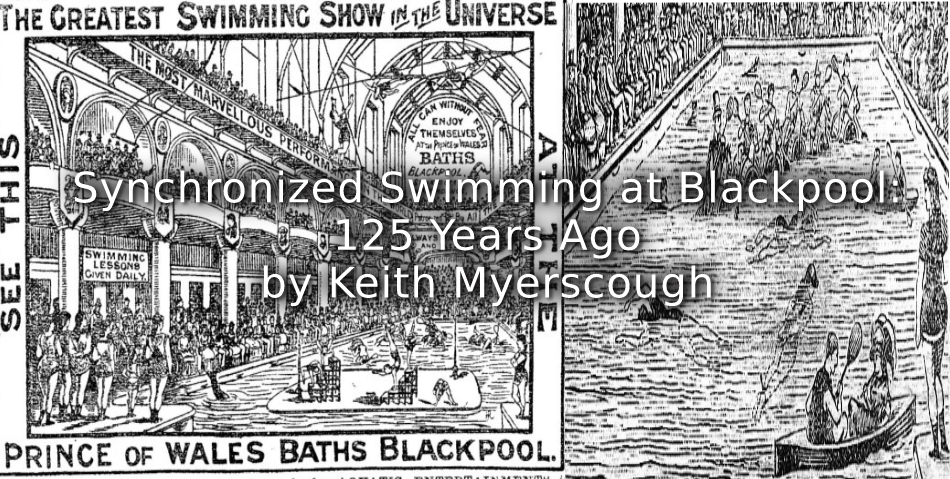With the Tokyo 2020 Olympic Games having taken place in 2021, it is an opportune time to set the record straight for FINA as to the origin of synchronized (artistic) swimming. Synchronized swimming joined the Olympic family at the Los Angeles Games in 1984. However, the sport was a popular spectator attraction for Lancashire’s working classes throughout the Victorian era.
This short article reveals the status of ‘Ornamental (Synchronized) Swimming’ in Lancashire, 125 years ago in 1896, at the birth of the Modern Olympic Movement. The Athens Games staged three swimming events in the Bay of Zea off the Piraeus Coast. At the same time, Blackpool’s summer season provided swimming as an entertainment in two purpose-built aquatic theatres. Commercial swimming was a working-class attraction at the Prince of Wales Baths and Aquatic Theatre and the Blackpool Tower Aquatic and Variety Circus. It was the seaside resorts mission to cater for the health, pleasure and recreation of their visitors.
Prince of Wales Baths and Aquatic Theatre

Prince of Wales Baths and Aquatic Theatre
In 1896 the Prince of Wales Baths was embarking on its sixteenth season as an aquatic theatre. It had been financed by stakeholders in the Lane Ends Company from Preston, who were committed leisure entrepreneurs. The company had built a hotel, swimming baths, and variety theatre on a prime site on the Central Promenade. Their business plan provided leisure facilities for a wide range of customers visiting Blackpool as short-stay or day-trippers. The decision to build an aquatic theatre not only proved profitable but also a stimulus to the development of ornamental swimming.
An insight into the type of performances on display in 1896 is provided by a detailed account of the entertainment on offer, written by ‘Nemo’ of the Birmingham Chronicle:
The entertainment began with an ‘overture on the piano’, followed by acrobat Monsieur Ruri who, ‘executed with much gracefulness and remarkable ease, a number of difficult feats’. He was performing on the invisible wire and the high trapeze. Ruri’s act was followed by the first swimmer, Mademoiselle Le Grande, who dived into the water at one end of the swimming pool and swam the full length under water, a distance of 107 feet. She was described as an ‘accomplished young lady who executed almost as many feats in the “briny” as a gymnast could perform on the stage’. She was then joined by child-performer, Little Lottie, ‘The Floating Wonder’, who ‘exhibited some really clever tricks in addition to floating on the surface of the water in a manner as graceful and natural as to win for her continued applause’.
The next artiste to perform was Professor James Finney, ‘The Amphibious King’. He was considered to ‘stand at the head of his profession, as his feats are simply astounding’. He began his performance by giving an imitation of a novice swimmer learning how to swim which was described as being ‘screamingly funny’, keeping the audience in ‘roars of laughter’. The entertainment was brought to a conclusion with an Aquatic Derby, which in Nemo’s opinion, was ‘the most side-splitting farce ever seen in a bath’. He described the race as involving four hobby horses that had been named after prominent politicians of the day: Gladstone, Salisbury, Chamberlain, and Parnell. The jockeys on the ‘steeds’ were tasked with attempting to race across the baths, but invariably fell off on numerous occasions due to the instability of the mounts, and because of the inevitable collisions that occurred in such a confined space. Thus, ended ‘two hours of entertainment Mr. Broadhead [the proprietor] provides for sixpence’.
Blackpool Tower Aquatic and Variety Circus

Blackpool Tower Aquatic and Variety Circus
The Blackpool Tower complex was opened to the public in time for the 1894 summer season. The Tower epitomized the business acumen of the town’s Victorian leisure entrepreneurs in offering a wide variety of amusements to their working-class clientele. The Blackpool Tower Company was able to give their visitor’s value-for-money for their ‘leisure sixpence’. The best entertainers were employed to perform in luxurious, purpose-built facilities. Visitors experienced: an aquarium, menagerie, dance hall, café restaurant, roof garden, the tower, and circus. In August, 1896, the Tower Circus employed the best natationists to perform twice-daily in a ‘Grand Water Show’.

The arena floor in the circus was lowered to the bottom of a water tank, exposing a salt water lake. Ornamental swimmers were engaged to perform a variety of aquatic feats to audiences as an integral part of the circus entertainment. Four of the eleven acts were performed by natationists: the eighth act on the programme was titled, ‘The Four Sisters Johnson’, followed by Joey Nuttall, ‘Champion Swimmer of the World’, then Professor Finney and his sister Marie, giving an ‘Exhibition of Scientific Swimming’, and the dénouement to the show, ‘A Fantastic Aquatic Pantomimic Extravaganza’.


All of the leading aquatic entertainers of the period were given sobriquets: Joey Nuttall was referred to as the ‘Champion of Champions’; Professor James Finney was called the ‘Champion all-round swimmer of the world’; Marie Finney, the ‘Heroine of London Bridge’; the Sisters Johnson were known as the ‘Champion lady swimmers of the world’; and, Miss Hermione, ‘The greatest scientific and ornamental lady swimmer in the Universe’. The common denominator was that they had all stood at the head of their profession as competitive speed or long-distance swimmers, and had moved into ornamental swimming as a means of earning a lucrative living. This was of particular significance to the working-class female performers as it provided them with a degree of independence and an income of their own.
World-wide public attention was rightly focused on the Tokyo 2020 Olympics. Undoubtedly the Olympians of 2021 will endeavour to go ever ‘Faster, Higher, Stronger’. At a time when we wish to be entertained by the sporting prowess of the world’s best Olympic athletes, it is apposite to recall what the caprices of time have hidden from our historical gaze.





